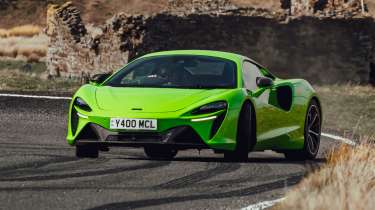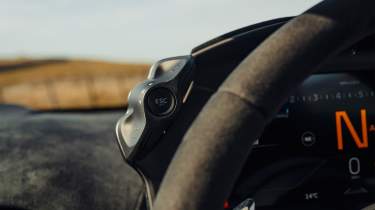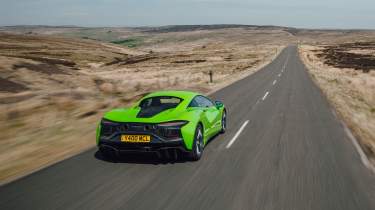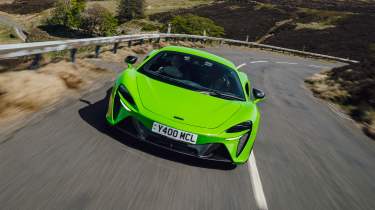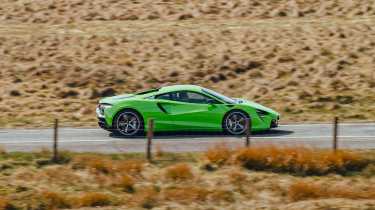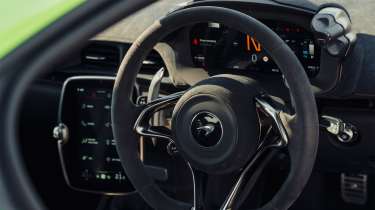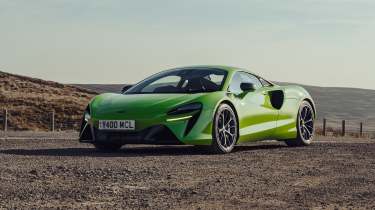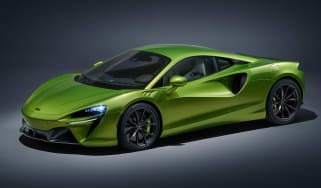McLaren Artura 2025 review – the ultimate entry-level supercar
Does hybrid power dilute the McLaren experience? Not a bit of it – the Artura is one of the most communicative, intensely involving supercars on sale
evo verdict
The Artura is a triumph. It may have had a difficult, protracted birth, but it’s evolved into a truly great supercar – at this price its feedback and involvement are unrivaled. An MC20 is more ferocious and full of drama, but the McLaren pulls you in with its stunning steering, poise across the ground and the massive hit from its hybrid V6.
It’s not perfect, with a slight dead spot in the brake pedal and lack of rear end control over the most punishing roads, but you only really notice these because of how polished the Artura is as a whole. It’s the ultimate entry level supercar for those who love driving – even if it does cost over £200k.
Background and model range
The Artura launched as an all-new McLaren supercar, and those don’t come around very often. In fact, you’ll need to look back to the MP4-12C for the last McLaren that was truly a clean-sheet car. In the Artura, you won’t find the usual twin-turbocharged M838T/M840T V8 engine or seven-speed dual-clutch transmission, but a new hybrid V6 powertrain developed specifically for the car. It’s not built around a derivative of the MonoCell carbonfibre tub, either. There’s a bespoke electrical architecture, bespoke multi-link rear suspension and, for the first time on a modern McLaren, an electronically controlled locking differential. Nailing home its significance, it’s also the first series-production hybrid to come out of Woking.
More reviews
Since we first got our hands on it in 2023, the Artura has been updated to polish those new ingredients further, and fight the likes of the Maserati MC20 and Ferrari 296 at the bottom of the supercar food chain (of course, that’s a relative term when talking about £200k+ machinery). More power and a retuned chassis came alongside the introduction of a Spider version in 2024, honing the package and giving it a broader appeal than before. But does the Artura really feel like a next-generation supercar, and has anything been lost in downsizing and going hybrid?
Engine, gearbox and technical highlights
- 690bhp, 8500rpm and electric torque fill for bespoke hybrid V6
- Brand new carbon structure, with no stiffness penalty for the Spider
- Conventional springs, dampers and roll bars rather than 750S-style hydraulics
Take a look at the specification and the technology of the Artura and you can see why the price has broken over £200k. It’s built around the new McLaren Carbon Lightweight Architecture, which consists of a new carbonfibre monocoque built in-house at a new facility near Sheffield, with aluminium crash structures at the front and aluminium rear subframes plus a new electrical system that uses Ethernet cabling rather than traditional wiring looms. Great for speed and connectivity and, in theory, much more robust when dealing with large temperature swings and electromagnetic interference. Oh, and it saves lots of weight, too. This is an industry-first application of the technology.
Cradled in that rear aluminium subframe is the new ‘M630’ 3-litre twin-turbocharged V6 engine. It’s McLaren’s first direct-injection engine and features a 120-degree angle and two turbochargers nestled in the wide vee. At 160kg it’s some 50kg lighter than the V8 and 190mm shorter, too. It’s a little jewel of an engine and produced 577bhp in its initial guise, revving to 8500rpm. With the Spider in 2024 came a bump in power to 597bhp for the combustion engine, and owners of early cars can have the engine remapped to the same spec free of charge.
An eight-speed dual-clutch gearbox, recalibrated for 25 per cent quicker shifts in the updated car, incorporates an e-diff and an axial flux e-motor (lighter, more efficient and much flatter than a radial flux motor) rated at 94bhp and 166lb ft. The e-motor sits directly on the input shaft in the bellhousing and also acts as a reverse gear. In combination, the Artura’s powertrain develops 690bhp and 531lb ft. A 7.4kWh battery pack is housed towards the rear of the monocoque floor, and all in, the hybrid system adds 130kg to the Artura’s overall 1498kg kerb weight. Up to 21 miles of electric range is possible in e-mode, too.
The Artura uses conventional adaptive dampers, springs and roll bars, rather than the hydraulically interlinked setup you’ll find on a 750S. The 2024 update brought a revised calibration and valving for the dampers, with quicker reactions to the driver’s inputs and the surface beneath. There were new engine mounts too, reducing movement of the powertrain under load. The chassis tuning is ramped up through Comfort, Sport and Track modes, with a variable ESC system offering a more lenient Dynamic setting and Variable Drift Control. Braking is by carbon ceramic discs and lightweight aluminium calipers, with the updated Artura gaining new brake cooling ducts.
Given the stiff carbon chassis, there’s no loss in rigidity in the Spider, and though it weighs 62kg more than the coupe, most of that is accounted for by the electric folding roof mechanism.
Driver’s note
‘That additional 20bhp might not read like much, it is after all less than a four per cent increase, but the remapping of how it’s delivered that focuses on allowing the V6 to rev out with more vigour is very noticeable.’ – Stuart Gallagher, evo Editor-in-Chief, who drove the McLaren Artura Spider on the launch in France
Performance, ride and handling
- Superbly communicative steering, compliant chassis
- V6 is revvy, responsive and massively potent, if a little bland in the sound department
- More polished and poised than an MC20
On the move the Artura feels new immediately, and not just because it starts in e-mode. Despite using conventional continuously variable dampers, coil springs and anti-roll bars rather than a 750S-style hydraulically linked set-up that attempts to decouple ride quality and roll stiffness, the ride is excellent. No surprise, for this is a McLaren trademark. However, not only is there control and poise but it’s so much quieter than previous models. Previously, you could hear the bumps and lumps even if you couldn’t feel them. With the Artura even the physical work going on to smooth the surface is magicked away.
But though the chassis deals quietly with lumps and bumps, the steering talks to you loud and clear. It’s superbly feelsome and precise, telegraphing the surface beneath and gently nudging away in your hands with bumps and cambers. There’s so much texture and raw information, and it makes an MC20 or 296’s steering feel numb in your hands by comparison. The flip side is that it can wriggle and writhe too much at times, kicking back over harsh ruts and imperfections.
Wake the engine by switching modes and you get to experience the next big change in the McLaren experience. The V6 is vocal enough but it’s extremely smooth and has a precise, highly tuned feel to the way it revs. With the assistance of the electric motor, there’s superb throttle response. In fact, the torque-fill is extremely effective and works much better than it did in the P1, for example. In McLaren’s fire-breathing hypercar you got the sense there wasn’t enough electric torque to fill in the holes in its 3.8-litre twin-turbocharged V8’s power curve, but here the electric motor is perfectly matched to the engine. The way the Artura is picked up and flung forwards in any gear from a few revs above tickover is stunning. And it doesn’t let up one bit before the limiter, although compared to a 296, you do miss having a multi-layered, musical engine note to accompany that performance.
As the roads bunch up, the weight can start to move around and you’ll want to add more support to the chassis by selecting Sport mode for handling. Worth clicking the Powertrain rocker switch right up to Track for maximum attack, too. Body control is much improved but the ride remains supple and the engine is at full noise and maximum response. The system also prioritises keeping the battery in a high state of charge to ensure maximum performance is available at all times. The ‘Target’ level of charge can be tailored via a menu system in each mode.
On twisting, broiling roads the Artura is indecently fast, piling on speed so rapidly that the numbers on the speed readout become a blur. Yet despite the frantic performance and huge forces at work there’s a coolness to the way it dissects whatever’s ahead. It’s highly responsive and alert but there’s a measured feel as you peel it into turns and not a hint of nervousness. There’s a slight dead spot in the brakes when you initially stand on them, but the Artura gives you huge confidence through its controls; it gives the sense of a car that’s operating well within itself. That only comes undone slightly on poor surfaces at speed, where you sense a lack of rebound control at the rear that can have the car pogoing behind you under hard loads. But by and large, the Artura moves with the kind of deftness that only comes from exceptional, high quality chassis tuning.
It’s happy to play the hooligan, too. Push through the grip, utilise the new e-diff and the Artura can be controlled precisely on the throttle, dancing underneath you and taking on bigger angles with more commitment. It’s a superbly exploitable car, and progressive in how it breaks away despite dumping nearly 700bhp to the rear tyres. Even better, the 15-stage Variable Drift Control allows experimentation and the confidence to push to a point that the rear wheels are speeding faster than the fronts. Add all this together and you have a truly engrossing supercar, rich in feedback, alive beneath you and spectacularly quick, yet delicate and sensitive in how it dissects a road. Once you get into a rhythm with the Artura, you don’t want to stop.
Driver’s note
‘The reclined seating position, the clear view out, the tactile steering, the supple ride – they all feel special and make you feel comfortably at one with the car straight away. That deep sense of connection through hands and backside meant that it was enjoyable and possessed flow, whatever the speed and whatever the road.’ – Henry Catchpole, evo contributor, who drove the McLaren Artura at evo’s 2024 Car of the Year test
Interior and technology
- A pure, purposeful driving environment – no steering wheel buttons in sight
- Clubsport seats are excellent
- Awkward tacked-on infotainment screen
Swing the door up and forwards, drop behind the steering wheel and the Artura is at once familiar and strangely new. The driving position is fantastic. You sit low in the ‘Clubsport’ seats (fixed back but the tilt angle of the entire seat is electrically adjustable), the pedal placement is perfect, and dead ahead is a simple, elegant steering wheel with not a button, switch or pimple of any sort to distract. Quality appears to have taken a noticeable step up compared to previous models, both in material choice and the crispness of the detailing. The view out is good too, although there isn’t perhaps the expansive view of the road you get from the ultra-low scuttle in other McLarens.
Infotainment is handled by a slightly awkward looking portrait display tilted towards you on the dash, and the instruments are fully digital. The dashboard is less cluttered than previous McLarens, partly due to the relocation of Handling and Powertrain controls. Previously, exploring these options required pressing a button marked ‘Active’ on the centre console and then turning two rotary switches to mix or match settings. Now there’s a rocker switch located on each side of the instrument binnacle, which floats on the adjustable steering column. They’re always active and ready. It’s possible to toggle between the four Powertrain settings of e-mode, Comfort, Sport and Track on the right-hand side and Comfort, Sport and Track on the left for Handling without your hands ever straying from the steering wheel itself.
Driver’s note
‘With the roof open there’s noticeable turbulence around the top of the pillar behind your outer shoulder, and if you drop the glass screen that sits between the buttresses when the roof is open you’re simply adding to the air ingress. Best to leave it in place until you raise the roof again, then you can drop it to hear the V6’s soundtrack, although with the roof closed and even with the optional sports exhaust it’s piped into the cabin through a Bowers & Wilkins speaker positioned between the seats.’ – Stuart Gallagher, evo Editor-in-Chief, who drove the McLaren Artura Spider on the launch in France
Price and rivals
The Artura might theoretically replace the previous Sport Series models, but its extra power and tech sees it priced much higher than what used to be considered an entry-level supercar. Since launch the price has climbed from £189,200 to £201,400 (and £221,500 for the Spider), putting it above super coupes like the £186,290 Mercedes-AMG GT63 S E Performance and Aston Martin’s £165,000 Vantage. The McLaren is easily special enough to justify that extra money, however, and undercuts similarly exotic metal like the Maserati MC20, which comes in at £227,755. Ferrari no longer sells the 296 GTB, but if you’re willing to venture onto the second-hand market, you can pick up a low-mileage used example for around £200k.
At this level there are other big ticket supercars available in the classifieds, not least lightly-used 720S’s and early Ferrari 812 Superfasts, the latter offering a completely different flavour with its searing, front-mounted V12. Lamborghini’s brilliant Huracán Tecnica is available too, delivering a more savage, vivid driving experience than the McLaren but lacking its fluidity and connection.
| Engine | 2993cc, twin-turbo, plus axial flux e-motor |
| Power | 690bhp (combined) @ 7500rpm |
| Torque | 531lb ft @ 2250-7000rpm |
| Weight | 1498kg |
| Power-to-weight | 468bhp/ton |
| 0-62mph | 3.0sec |
| Top speed | 205mph |
| Basic price | £201,400 |
